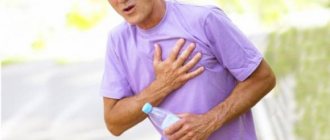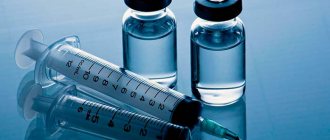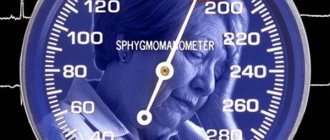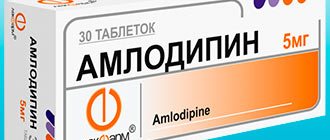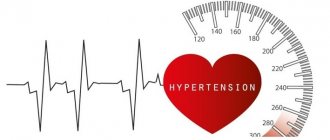Every third adult in our country has problems with high blood pressure. Hypertension, like any other pathology, is easier to prevent than to treat. The insidiousness of the presented disease is that in the early stages of its development it does not manifest itself clinically. The person does not even suspect that he is seriously ill.
To normalize blood pressure, various methods, both medicinal and non-medicinal, can be used. If you have arterial hypertension, it is useful to apply ice compresses to the back of the head and neck. Doctor A.Yu., Candidate of Medical Sciences, specialist in cardiology, organizer of the “Club of Former Hypertensive Patients” talks about why cold lowers blood pressure. Shishonin.
Expert opinion
Most people believe that applying cold to the back of the head increases blood pressure. However, Dr. Shishonin denied this version.
The human body works on reflexes. This is the main part of the life of our body, which we are not aware of. The reflex of contact with cold is quite simple, that is, if you apply cold to the back of your head, the body perceives it as if you had fallen into an ice hole. In order to warm the body, the brain gives a command to the capillaries of the body to expand.
The mechanism of cold action on the body is quite simple. In this case, expansion of capillaries is observed in all muscles and internal organs. Thus, the pressure will inevitably decrease, that is, if small vessels in the system open, the pressure drops.
Interesting.
It is useful for hypertensive patients to know that prolonged exposure to the cold or in a cold room is fraught with an increase in blood pressure due to changes occurring in the body.
To receive the most up-to-date information from Dr. Shishonin, join our community Club of Former Hypertensive Patients
Dr. Shishonin recommends applying cold to the neck and back of the head for a few seconds (from 15 to 60 seconds). The ice pack does not need to be kept in one place. It's best to move it constantly. This is how cryomassage is performed. After this procedure, you must wipe your neck dry with a towel.
Dr. Shishonin recommends applying cold to the neck and back of the head for a few seconds (from 15 to 60 seconds). The ice pack does not need to be kept in one place. It's best to move it constantly. This is how cryomassage is performed. After this procedure, you must wipe your neck dry with a towel.
If you keep the compress for several minutes, you can chill the ligaments, muscles and even bones. You will experience aseptic (non-bacterial) inflammation. The body will fight the cold, macrophages and immune system cells will come to the affected area, which will begin to protect the body from the effects of a negative factor. All these actions will lead to the formation of edema and clamping of the vertebral arteries.
Little blood, and therefore little oxygen, begins to flow into the brain. The vascular center increases pressure, as a result of which a person develops hypertensive syndrome or even a hypertensive crisis. The swelling will go away in one or even two weeks, so the person will suffer all this time.
Note.
The occipital region is good not only for regulating blood pressure, but also for normalizing overall health. After such procedures, a person feels more energetic, his brain activity and physical activity improve.
gormed.su
Low blood pressure is not as common as hypertension, however, it brings no less trouble. Women especially suffer from hypotension during pregnancy and those who are on a diet.
The main symptoms of impending fainting against the background of low pressure are arrhythmia, severe headache, lightheadedness, flashing of black or white luminous spots before the eyes. Basic first aid methods for low blood pressure are suitable both for those who have an attack alone, and for people who are on the street or in a public place.
- If you feel symptoms that indicate imminent fainting, you need to sit down. Keep your breathing calm and lower your head down to knee level. Even if you feel better, rest for another 20-30 minutes without getting up.
- If there is a sudden deterioration in your general condition (very dizzy), use acupuncture (acupressure). For 3 minutes, you need to massage the point between the base of the nose and the lip (helical movements). The second option is a point on the little finger of the hand, near the nail, closer to the ring finger. It is advisable to massage both fingers. This is first aid that can be done independently without attracting undue attention, for example, at a lecture or in the theater.
- To relieve spasmodic headaches, massage your neck, arms and back of your head with force. You can put mustard plasters on your calves for 5 minutes. At work, it will be more convenient to immerse your hands in hot water up to your elbows for 10 minutes, and then quickly and vigorously rub your limbs.
- A heating pad will relieve sudden loss of strength. Apply it to your neck, forehead, ears and nose. A glass of hot tea will replace a heating pad in the workplace. They can warm your nose and hands.
- Aromatherapy. A couple of drops of essential oil on a handkerchief will help restore strength. Breathing calmly for 5 minutes can work wonders. Use lavender, jasmine, mint, rosemary, and clove oils.
- Regular exercise will help relieve drowsiness. Sitting on a chair, spread your legs and cross your arms behind your head. Slowly lower yourself to your knees, taking a deep breath before doing so. As you exhale, straighten up. Three times is enough to improve blood circulation.
- If low blood pressure constantly bothers you, then it’s a good idea to take walks instead of lying or sitting. This is especially true for pregnant women, whose blood pressure monitoring is mandatory. When moving, blood circulates faster through the veins, which helps to warm the body faster. If an attack threatens to occur while you are walking, then you should go to the nearest cafe for hot tea or coffee.
If blood pressure regularly drops below a critical level, then it is worth visiting a doctor and undergoing a course of treatment, including taking tonic drugs and adaptogens.
First aid for hypertensive crisis
Hypertensive crisis (HC) is a condition manifested by high blood pressure (systolic “upper” blood pressure, usually more than 180 mm Hg; diastolic “lower” blood pressure - more than 120 mm Hg) and the following symptoms:
- headache, often in the occipital region, or heaviness and noise in the head;
- flashing “flies”, a veil or a net before the eyes;
- nausea, feeling of exhaustion, overwork, internal tension;
- shortness of breath, weakness, constant monotonous aching pain/discomfort in the heart area;
- the appearance or increase in pastosity/swelling of the skin of the face, arms, legs.
First aid measures
If symptoms of a hypertensive crisis appear, you must:
- Remove bright light, ensure peace, access to fresh air (unbutton your shirt collar, ventilate the room, etc.).
- Measure blood pressure (see the method for measuring blood pressure at the end of this section), and if its “upper” level is higher than or equal to 160 mm Hg. Art., you must take an antihypertensive drug previously recommended by your doctor. In the absence of a doctor-recommended antihypertensive drug or when a blood pressure level is recorded above 200 mm Hg. Art. urgently need to call an ambulance.
- Before emergency medical services arrive, you should, if possible, sit in a chair with armrests and take a hot foot bath (put your feet in a container of hot water).
Attention!
A patient with a hypertensive crisis is prohibited from any sudden movements (suddenly standing up, sitting down, lying down, bending over, pushing) and any physical activity.
- 40-60 minutes after taking the medicine recommended by the doctor, it is necessary to re-measure blood pressure, and if its level has not decreased by 20-30 mm Hg. Art. from the initial state and/or the condition has not improved - urgently call an ambulance.
- If you feel better and your blood pressure decreases, you need to rest (go to bed with the head of the bed raised) and then contact your local (family) doctor.
When talking with your doctor, you need to clarify what medications you need to take if you develop a hypertensive crisis, clearly write down their names, dosage and time sequence (algorithm) for taking them, and also check with your doctor for what manifestations of the disease you need to urgently call an ambulance.
All patients with hypertension need to create an individual mini-first aid kit for a hypertensive crisis and carry it with them at all times, since a hypertensive crisis can develop at any time and anywhere.
Blood pressure measurement
To diagnose a hypertensive crisis, it is necessary to measure blood pressure, which is performed manually using a stethoscope (stethophonendoscope) and a special inflatable cuff equipped with a bulb pump and a sphygmomanometer, as well as an automatic (semi-automatic) method using various models of tonometers specially designed for these purposes .
The accuracy of blood pressure measurement and, accordingly, the guarantee of correct diagnosis and severity of a hypertensive crisis depend on compliance with the rules for its measurement.
The measurement should be taken while sitting, leaning on the back of a chair, with relaxed and uncrossed legs, the hand resting on the table at heart level, in a calm environment, after a 5-minute rest. During the measurement, you should not actively move or talk. In special cases, blood pressure can be measured while lying down or standing.
The cuff is placed on the shoulder, its lower edge 2 cm above the elbow. The size of the cuff must correspond to the size of the arm: the rubber inflated part of the cuff must cover at least 80% of the shoulder circumference; for adults, a cuff 12–13 cm wide and 30–35 cm long (average size) is used; It is necessary to have large and small cuffs available for fat and thin arms, respectively.
Before starting the measurement, the mercury column or sphygmomanometer needle should be at the zero mark and in front of the researcher’s eyes.
Blood pressure measurement technique:
- Place the head of the phonendoscope in the cubital fossa above the brachial artery passing through it.
- Quickly inflate the cuff to a pressure of 20–30 mmHg. Art. higher than the normal level of “upper” systolic blood pressure for a given person. If the measurement is made for the first time, the pressure level in the cuff is usually raised to 160 mmHg. Art. If at this pressure level the pulsation of the vessel in the cubital fossa remains, then the pressure in the cuff continues to be increased to a level of 20 mm Hg. Art. above the pressure level at which the pulsation of the artery in the cubital fossa disappears.
- Open the air release valve from the cuff, located next to the pump bulb, and reduce the pressure in the cuff at a speed of approximately 2–3 mm Hg. Art. per second.
- As air is released from the cuff, two parameters are simultaneously monitored: the pressure level on the manometer scale, and the appearance of artery pulsation sounds (called Korotkoff sounds) in the cubital fossa. The pressure level at the moment of the appearance of pulsation sounds corresponds to the level of “upper” systolic blood pressure, and the pressure level at the moment of complete disappearance of arterial pulsation sounds corresponds to the “lower” diastolic blood pressure. In children, adolescents and young people immediately after physical activity, in pregnant women and in some pathological conditions in adults, arterial pulsation sounds do not disappear, then the “lower” diastolic blood pressure should be determined by the moment of significant weakening of the sounds.
- If the pulsation sounds of the artery in the cubital fossa are very weak, then you should raise your hand and perform several squeezing movements with the hand, then repeat the measurement, but you should not strongly compress the artery with the phonendoscope membrane.
- When measuring blood pressure yourself, the head of the phonendoscope is fixed above the cubital fossa using a cuff.
For a reliable assessment of blood pressure, it is necessary to take at least two blood pressure measurements on each arm with an interval of at least a minute; in the pauses between measurements, it is necessary to completely loosen the cuff. If a pressure difference of more than 5 mm Hg is detected. Art. One additional measurement is made; the average of the last two measurements is taken as the final (recorded) value.
Source: Boytsov S. A., Ipatov P. V., Kalinina A. M., Vylegzhanin S. V., Gambaryan M. G., Eganyan R. A., Zubkova I. I., Ponomareva E. G., Solovyova S. B., “Organization of clinical examination and preventive medical examinations of the adult population.” Guidelines. 2nd edition with additions and clarifications, M., 2013.
All articles

